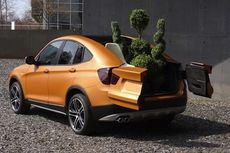
Photo CU-ICAR
Clemson student engineers test-drive the frame and working parts of their creation, Deep Orange 3.

Clemson UniversityPhoto CU-ICAR
On the home page: Students designed a trunk compartment with the open-bed configuration of a pickup truck, Deep Orange 4.
For the seventh iteration of Deep Orange, the goal is to develop a blank-sheet fully functional vehicle concept for the MINI brand targeting the U.S. market with the BMW Group in Munich as the primary sponsor. The objective is to create a revolutionary MINI technology demonstrator facing the potential requirements to come within the next decade as part of a collaborative real-world educational experience (Deep Orange 7).
The project outcome will provide a unique U.S.-centric view on what could be next for MINI.
CU-ICAR will again partner with the Art Center College of Design in Pasadena, California, to create the vehicle’s external look and feel. The California design school last worked on the program for the Toyota-sponsored Deep Orange 6 vehicle.
The BMW Group, whose global headquarters are in Munich, Germany, will sponsor Deep Orange 7. Clemson University has been as a strategic partner to BMW since 2008, initially focused mostly on the BMW Manufacturing plant in Greer.
As part of the graduate automotive engineering program at CU-ICAR, students are required to create and manufacture a new vehicle prototype. The project showcases advanced technology and provides students an opportunity to work directly with automotive industry partners to develop ideas.
Deep Orange runs the course of two academic years in parallel with Clemson’s two-year master’s program in automotive engineering. The program provides students with experience in financial and market analysis, vehicle design, development, prototyping and production planning.
Paul Venhovens, who leads the Deep Orange program at CU-ICAR said, “The students’ task is to develop a vehicle that not only builds off the hugely successful MINI brand, but also addresses important issues, such as creating a new level of desirability and relevance among the next generations of U.S. MINI buyers, including working out concepts to achieve future fuel economy and safety standards in a very small vehicle footprint.”